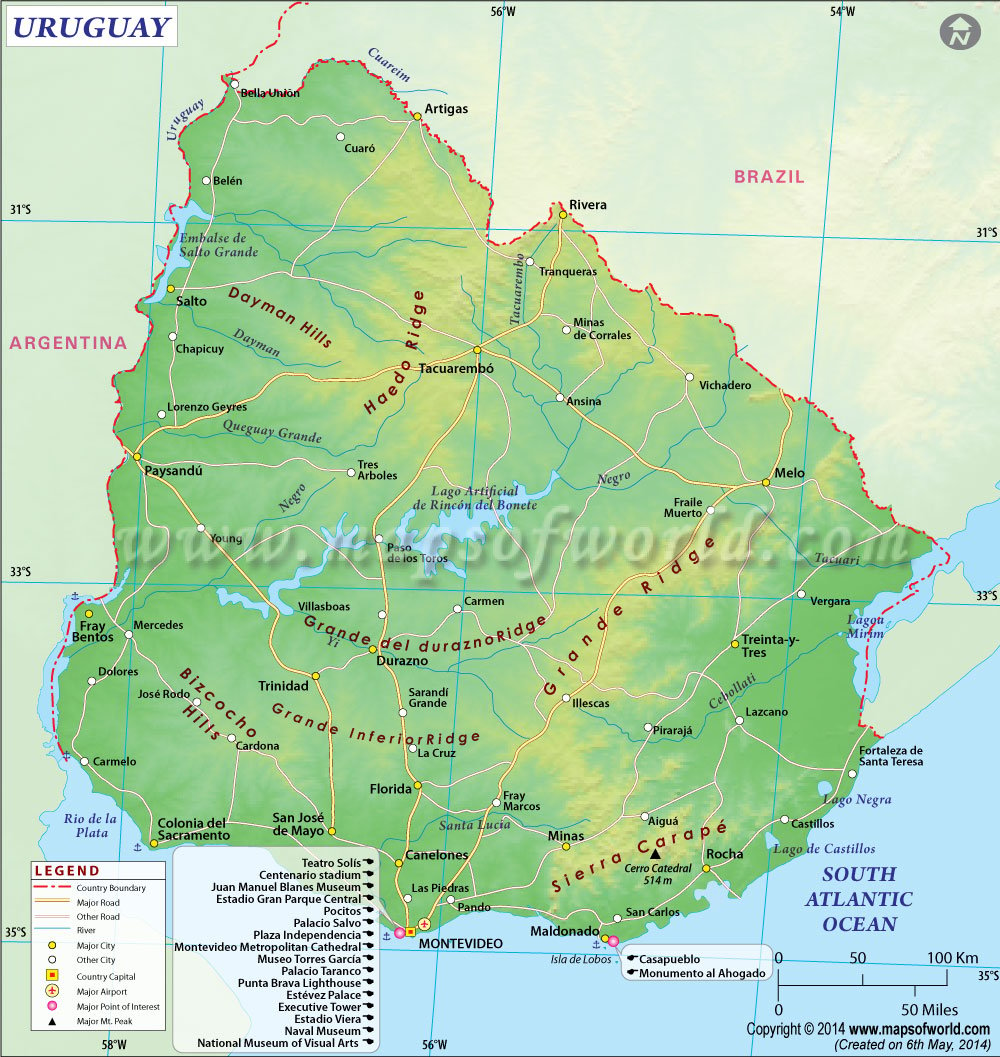About Uruguay
Explore this Uruguay map to learn everything you want to know about this country. Learn about Uruguay location on the world map, official symbol, flag, geography, climate, postal/area/zip codes, time zones, etc. Check out Uruguay history, significant states, provinces/districts, & cities, most popular travel destinations and attractions, the capital city’s location, facts and trivia, and many more.
| Full name: | Republic of Uruguay or República Oriental del Uruguay |
| Capital City: | Montevideo |
| Language: | Spanish, Latin American Spanish, Portuguese and Portunol, or Brazilero |
| Currency: | Uruguayan Peso |
| Religion: | Roman Catholic, Protestant and Judaism |
| National Anthem: | “Orientales, la Patria o la tumba” |
| Newspaper: | Bpp-Color, Diario el Observador, El Heraldo, El Observador, Observa and Uruguay Press |
| Places to Visit: | Montevideo, Uruguayan Riviera, Mercado del Puerto, Museo Didáctico Artiguista and Parque Nacional Santa Teresa. |
| Transport: | Airports; Railways; Roadways; Waterways/Ports:-Montevideo, Nueva Palmira, Fray Bentos, Colonia and Juan Lacaze. |
| Shopping: | suede jackets, Amethyst jewelry and paintings and antiques. |
Once a Spanish colony and an annexe of Brazil, it became a strong military base and also a thriving business support due to its convenient harbors. However, even after its freedom from Brazil, the country has been through a lot of political upheaval post-independence. Now, the current situation in Uruguay is such that is possesses the most liberal labor and political scenario in the entire continent.
Climate of Uruguay
Uruguay is well known for its pleasant tropical climate which lasts the year round. Winters and chilly climate is quite unheard of, as far as Uruguay is concerned. The summers are warm and temperate at the same time.
Flora and Fauna of Uruguay
Uruguay is well forested, with most of the forest containing hardwood trees. Some of the hardwood breeds are algarobo, arazá, guayabo, urunday, coronilla, quebracho, lapacho, lignum vitae, espinillo and nandubay. The other varieties of fauna to be found in Uruguay, which are not a part of the hardwood varieties, are poplar, acacia, aloe, alder, ombú, eucalyptus and willow. Flowers include Rosemary, myrtle, scarlet-flowered ceibo, white and scarlet verbena and mimosa. The fauna in Uruguay is not as diverse or abundant as the flora of the country. Marine life thrives in Uruguay, with the salmon and the pompano forming the majority of the catch. However, the corvine is not scarce either. Avian fauna comes in many species. These include the royal duck, swan, avestruz, partridge, quail, hornero and, of course the crow. However, some types like the small armadillo, otter, nutria, deer, fox and carpincho are to be found at the edges of the hills. The list of reptiles and amphibians include tortoises, seals and cross vipers.
Location of Uruguay
Uruguay is a drop shaped landmass located in the continent of South America; sandwiched between the countries Argentina and Brazil. It is surrounded by the water bodies of South Atlantic Ocean and the Rio de la Plata.
Physical Map of Uruguay
Uruguay is a well watered country with oceans surrounding it and rivers channeling their way across its territory. The landscape of Uruguay mainly comprises of vast expanses of plains and low lying coastal land. If at all, the hills in Uruguay are very low in comparison to most other hills in other countries.
People of Uruguay
The people of Uruguay belong to diverse ethnic races and categories that transcend continental boundaries. This factor is a direct result of their chequered history. The main categories of people belong to the classifications of black-skinned, white-skinned, Mestizo, Amerindian, Portuguese and Spanish.
Arts, Culture and Music of Uruguay
the culture of Uruguay has several external influences mingled with its native tradition. There is the African, the brazilian, the Spanish and many others. Uruguay has its own distinctive music forms. Two such unique forms are the ‘Candombe’ and the ‘Murga’. The candombe is an Afro-Uruguayan style which is dominantly drum-based; while the murga is a kind of opera or musical drama.
Flag of Uruguay
the flag of Uruguay is rectangular in shape and simple in design. The dominant colors are blue, white and yellow. The flag comprises of a total of nine horizontal and alternating stripes of the colors blue and white.
In the top left corner of the flag is a white square containing a yellow sun, with sixteen alternately wavy and triangular rays and sporting the face of a man. This particular type of sun is called the “Sun of May”. The Sun of May is the official national symbol of Uruguay. The colors blue and white are borrowed from the Argentinean flag; white the nine stripes are emblematic of the nine different departments of Uruguay.
Economy of Uruguay
Uruguay has all the conditions to facilitate a smooth economic condition in the country. It as much abundant fertile agricultural land as mineral resources and to boost all these factors, a plentiful marine life too. The major industries in Uruguay are food (especially meat) processing, electrical machinery, production of hydro-power, mining, transportation equipment, manufacturing leather products, petroleum products, wool, textiles, chemicals, beverages

